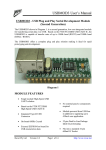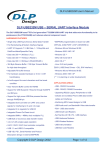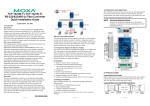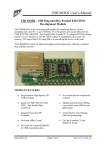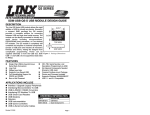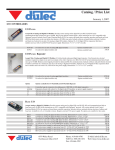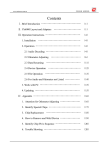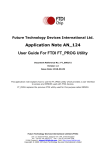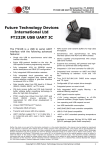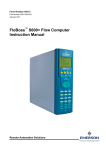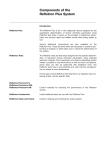Download USBMOD4 User`s Manual
Transcript
USBMOD4 User’s Manual USBMOD4 - USB Plug and Play Parallel 8-Bit FIFO Development Module (Second Generation) The USBMOD4 shown in Diagram 1, is a second generation, low-cost integrated module for transferring data to / from a peripheral and a host PC at up to 8 Million bits (1 Megabyte) per second. Based on the FTDI FT245BM USB FIFO – Fast Parallel Data Transfer IC, it’s simple FIFO-like design makes it easy to interface to a CPU (MCU) either by mapping the device into the memory / I/O map of the CPU, using DMA or controlling the device via I/O ports. The USBMOD4 offers a complete plug and play solution making it ideal for rapid prototyping and development. Diagram 1 MODULE FEATURES • • • • • Single module High-Speed USB UART solution • No external passive components required Based on the FTDI FT245BM USB FIFO – Fast Parallel Data Transfer IC • Module powered from USB bus in addition to supplying up to 460mA for user application Integrated Type-B USB Connector • 32-pin Dual In-Line Package (Ideal for prototyping) • Fits into a standard 32-pin 600mil IC Socket On-board 6MHz Crystal External EEPROM for USB enumeration data Ravar Pty Ltd Version 1.0 Page 1 of 15 http://www.ravar.net USBMOD4 User’s Manual FT245BM IC FEATURES • Single Chip Multi-Function Data Transfer Solution • Send / Receive Data over USB at up to 1 Mb / Sec • 384 byte receive buffer / 128 byte transmit buffer for high data throughput • Simple interface to CPU or MCU bus • No in-depth knowledge of USB required as all USB Protocol is handled automatically within the I.C • FTDI’s Virtual COM port drivers eliminate the need for USB driver development in most cases. • Compact 32 pin (7mm x 7mm) MQFP package • UHCI / OHCI Compliant • USB 1.1 and USB 2.0 Compatible • USB VID, PID, Serial Number and Product Description Strings in external E2PROM. VIRTUAL COM PORT (VCP) DRIVERS for • Windows 98, 98 SE and ME • Windows 2000 / XP • Windows CE ** • MAC OS-8 and OS9 • MAC OS-X • Linux 2.40 and greater [** = In the planning or under development] • Integrated 6Mhz – 48Mhz Clock Multiplier aids FCC and CE compliance • Integrated 3.3v Regulator – No External Regulator Required FTD2XX (USB Direct Drivers + DLL S/W Interface) • Windows 98, 98 SE and ME • Windows 2000 / XP ENHANCEMENTS This section summarises the enhancements of the 2nd generation device compared to its FT8U245AM predecessor. For further details, consult the device pin-out description and functional descriptions. Ravar Pty Ltd Version 1.0 Page 2 of 15 http://www.ravar.net USBMOD4 User’s Manual • Integrated Power-On-Reset (POR) Circuit The device now incorporates an internal POR function. The existing RESET# pin (RSTI on the module) is maintained in order to allow external logic to reset the device where required, however for many applications this pin can now be either left N/C or hard wired to VCC (+V on the module). In addition, a new reset output pin (RSTO# or RSTO on the module) is provided in order to allow the new POR circuit to provide a stable reset to external MCU and other devices. RSTO# was the TEST pin on the previous generation of devices. • Integrated RCCLK Circuit In the previous devices, an external RC circuit was required to ensure that the oscillator and clock multiplier PLL frequency was stable prior to enabling the clock internal to the device. This circuit is now embedded on-chip – the pin assigned to this function is now designated as the TEST pin and should be tied to GND for normal operation. • Integrated Level Converter on FIFO interface and control signals The previous devices would drive the FIFO and control signals at 5v CMOS logic levels. The new device has a separate VCC-IO (VIO on the module) pin allowing the device to directly interface to 3.3v and other logic families without the need for external level converter I.C.'s • Power Management control for USB Bus Powered, high current devices A new PWREN# signal (/PEN on the module) which can be used to directly drive a transistor or P-Channel MOSFET in applications where power switching of external circuitry is required. A new EEPROM based option makes the Ravar Pty Ltd Version 1.0 device pull gently down its FIFO interface lines when the power is shut off (PWREN# is High). In this mode, any residual voltage on external circuitry is bled to GND when power is removed thus ensuring that external circuitry controlled by PWREN# resets reliably when power is restored. PWREN# can also be used be external circuitry to determine when USB is in suspend mode (PWREN# goes high). • Lower Suspend Current Integration of RCCLK within the device and internal design improvements reduce the suspend current of the FT245BM to under 200uA (excluding the 1.5k pull-up on USBDP) in USB suspend mode. This allows greater margin for peripherals to meet the USB Suspend current limit of 500uA. • Support for USB Isocronous Transfers Whilst USB Bulk transfer is usually the best choice for data transfer, the scheduling time of the data is not guaranteed. For applications where scheduling latency takes priority over data integrity such as transferring audio and low bandwidth video data, the new device now offers an option of USB Isocronous transfer via an option bit in the EEPROM. • Programmable FIFO TX Buffer Timeout In the previous device, the TX buffer timeout used to flush remaining data from the receive buffer was fixed at 16ms timeout. This timeout is now programmable over USB in 1ms increments from 1ms to 255ms thus allowing the device to be better optimised for protocols requiring faster response times from short data packets. Page 3 of 15 http://www.ravar.net USBMOD4 User’s Manual • Send Immediate / Wakeup (SI/WU) signal The new Send Immediate / WakeUp signal combines the two functions on a single pin. If USB is in suspend mode (and remote wakeup is enabled in the EEPROM), strobing this pin low will cause the device to request a resume from suspend (WakeUp) on the USB Bus. Normally, this can be used to wake up the Host PC. During normal operation, if this pin is strobed low any data in the device RX buffer will be sent out over USB on the next Bulk-IN request from the drivers regardless of the packet size. This can be used to optimize USB transfer speed for some applications. • Relaxed VCC Decoupling The 2nd generation devices now incorporate a level of on-chip VCC decoupling. Though this does not eliminate the need for external decoupling capacitors, it significantly improves the ease of PCB design requirements to meet FCC, CE and other EMI related specifications. • Bit Bang Mode The 2nd generation device has a new option referred to as “Bit Bang ” mode. In Bit Bang mode, the eight FIFO data lines can be switched between FIFO interface mode and an 8-bit Parallel IO port. Data packets can be sent to the device and they will be sequentially sent to the interface at a rate controlled by an internal timer (equivalent to the prescaler of the FT232BM device). As well as allowing the device to be used standalone as a general-purpose IO controller for example controlling lights, relays and switches, some other interesting possibilities exist. For instance, it may be possible to connect the device to an SRAM configurable FPGA as supplied by vendors such as Altera and Xilinx. The FPGA device would normally be un-configured (i.e. have no defined function) at power-up. Application software on the PC could use Bit Bang Mode to download configuration data to the FPGA, which would define its hardware function, then after the FPGA device is configured the FT245BM can switch back into FIFO interface mode to allow the programmed FPGA device to communicate with the PC over USB. This approach allows a customer to create a “generic ” USB peripheral who ’s hardware function can be defined under control of the application software. The FPGA based hardware can be easily upgraded or totally changed simply by changing the FPGA configuration data file. Application notes, software and development modules for this application area will be available from FTDI and other 3rd parties. For further information regarding the FTDI FT245BM USB FIFO – Fast Parallel Data Transfer IC please refer to the FT245BM Datasheet. This datasheet can be found on the Ravar website at http://www.ravar.net As mentioned above in module features, the USBMOD4 is in a 32-pin Dual In-Line Package. This allows the module to fit into a standard 32-pin 600mil IC Socket which makes the module ideal for prototyping and development work. Shown in Diagram 2 below is the pin out for the USBMOD4. Ravar Pty Ltd Version 1.0 Page 4 of 15 http://www.ravar.net USBMOD4 User’s Manual USBMOD4 PINOUT PIN 1 PIN 32 2 31 3 30 4 29 5 28 6 27 7 26 8 25 9 24 10 23 11 22 12 21 13 20 14 19 15 18 16 17 DIAGRAM 2 On the following page is the pin out table showing what the various pins are on the module. Ravar Pty Ltd Version 1.0 Page 5 of 15 http://www.ravar.net USBMOD4 User’s Manual USBMOD4 PINOUT TABLE PIN # 1 2 3 4 5 6 7 8 SIGNAL TYPE DESCRIPTION G GND B+ +V ECS ECLK EDAT RSTI PWR PWR PWR PWR I/O I/O OUT IN 9 EP IN 10 RSTO OUT 11 3V3 OUT 12 VIO PWR 13 14 +V /PEN PWR OUT Device – Ground Supply Pin Device – Ground Supply Pin USB Bus Power Device - +4.4 volt to +5.25 volt Power Supply Pin EEPROM – Chip Select EEPROM – Clock EEPROM – Data I/O Can be used by external device to reset chip. If not required tie to VCC Enumeration Power connect to RSTO for bus powered operation or 3V3 to instruct PC to connect to device Output of the internal Reset Generator. Stays high impedance for ~2ms after VCC >3.5v and the internal clock starts up, then clamps it ’s output to the 3.3v output of the internal regulator. Taking RESET# low will also force RSTOUT# to go high impedance. RSTOUT# is NOT affected by a USB Bus Reset. 3.3 volt Output from the integrated L.D.O. regulator. This pin should be decoupled to GND using a 33nF ceramic capacitor in close proximity to the device pin. Its prime purpose is to provide the internal 3.3v supply to the USB transceiver cell and the RSTO pin. A small amount of current (<=5mA) can be drawn from this pin to power external 3.3v logic if required. +3.0 volt to +5.25 volt VCC to the FIFO interface pins 10..12,14..16 and 18..25. When interfacing with 3.3v external logic connect VIO to the 3.3v supply of the external logic, otherwise connect to +V to drive out at 5v CMOS level. Device - +4.4 volt to +5.25 volt Power Supply Pin Goes Low after the device is configured via USB, then high during USB suspend. Can be used to control power to external logic using a P-Channel Logic Level MOSFET switch. Enable the Interface Pull-Down Option in EEPROM when using the /PEN pin in this way. Ravar Pty Ltd Version 1.0 Page 6 of 15 http://www.ravar.net USBMOD4 User’s Manual USBMOD4 PINOUT TABLE Continued PIN # 15 SIGNAL TYPE DESCRIPTION SI/W IN 16 17 GND /RXF PWR OUT 18 /TXE OUT 19 WR IN 20 /RD IN 21 22 23 24 25 26 27 28 29 30 31 32 D7 D6 D5 D4 D3 D2 D1 D0 GND DD+ G I/O I/O I/O I/O I/O I/O I/O I/O PWR I/O I/O PWR The Send Immediate /WakeUp signal combines two functions on a single pin. If USB is in suspend mode (/PEN=1) and remote wakeup is enabled in the EEPROM, strobing this pin low will cause the device to request a resume on the USB Bus. Normally, this can be used to wake up the Host PC. During normal operation (PEN=0), if this pin is strobed low any data in the device RX buffer will be sent out over USB on the next Bulk-IN request from the drivers regardless of the pending packet size. This can be used to optimize USB transfer speed for some applications. Tie this pin high if not used. Device – Ground Supply Pin When high, do not read data from FIFO. When low, there is data available in the FIFO, which can be read by strobing /RD low the high again. When high, do not write data into the FIFO. When low, data can be written into the FIFO by strobing WR high then low. Writes the Data Byte on D0..D7 into the Transmit FIFO Buffer when WR goes from high to low. Enables Current FIFO Data Byte on D0..D7 when low. Fetches the next FIFO Data Byte (if available) from the Receive FIFO Buffer when /RD goes from low to high. Bi-Directional Data Bus Bit #7 Bi-Directional Data Bus Bit #6 Bi-Directional Data Bus Bit #5 Bi-Directional Data Bus Bit #4 Bi-Directional Data Bus Bit #3 Bi-Directional Data Bus Bit #2 Bi-Directional Data Bus Bit #1 Bi-Directional Data Bus Bit #0 Device – Ground Supply Pin USB Data Signal Minus USB Data Signal Plus Device – Ground Supply Pin The following page shows the schematic for the USBMOD4. Ravar Pty Ltd Version 1.0 Page 7 of 15 http://www.ravar.net Version 1.0 Page 8 of 15 29 32 2 16 1 4 13 20 19 21 23 22 25 24 27 26 28 8 C2 100nF 10nF C6 + C4 100nF VCC 16 15 25 24 23 22 21 20 19 18 31 4 /RD WR D0 D1 D2 D3 D4 D5 D6 D7 TEST /RST VCC GND GND AGND 12 13 VCCIO 3 26 30 VCC VCC AVCC R4 470 USBDP USBDM 3V3OUT RSTOUT# /TXE PWREN# /RXF SI/WU EESK EECS EEDATA XTIN XTOUT U1 FT 245B M C3 100nF R2 27R 1K5 C5 33nF R6 R3 C1 10nF 30 3 7 17 15 18 14 10 11 9 31 5 20 C2 27pF 1 2 3 4 VCC CON1 USB +V DATA+ DATAGND FB1 Ferrite Bead R5 2K2 COPYRIGHT 2002 RAVAR Pty Ltd www. ravar.net USB MOD4 Schematic R1 27R 7 8 6 5 14 10 12 11 1 32 2 27 28 X1 6MHz C3 27pF MODULE PINS Ravar Pty Ltd 9 17 29 VCC 6 1 2 3 4 R6 10K CS VCC SK NC DIN NC DOUT GND U2 93LC 66B 8 7 6 5 VCC USBMOD4 User’s Manual USBMOD4 SCHEMATIC http://www.ravar.net MODULE PINS USBMOD4 User’s Manual Driver Installation. Your first choice when using the USBMOD4 is whether you want to use the Virtual Com Port driver or the Direct DLL driver. For programming simplicity the best driver is the Virtual Com Port and when installed the USBMOD4 will appear in the System Properties / Device Manager as an USB Serial Port (COMn) as follows. The Com Port number will vary depending on the number of existing Com Ports on your computer and the number of USBMOD4’s connected to your system. To install the Virtual Com Port drivers, download the driver from our website or the ftdichip.com website and unzip the files to a local directory. Then connect the USBMOD4 and windows will automatically ask for the driver. Select to specify a location and browse to the directory where you have unzipped the files. (Use the Non Plug & Play driver for the USBMOD to avoid a delay identifying) Ravar Pty Ltd Version 1.0 Page 9 of 15 http://www.ravar.net USBMOD4 User’s Manual Once the Virtual Com Port is installed it can be programmed exactly as a regular serial com port using the MSComm control from Visual Basic or API calls from C or other languages. Set the com port to the same number as appears in the Device Manager, the baud rate, stop bits, parity etc are not used as the device always runs at full speed. The Direct DLL driver is installed in a similar manner but using the alternative download from the website. Programming the Direct DLL driver is by call to the DLL Library functions. Please download the Direct DLL programmers guide from the Ravar website. Application Notes On the following pages there is a schematic drawing showing a sample application for the USBMOD4. The application shows how to interface the USBMOD4 to a micro controller. We are using a PIC 16C84 in this application but any micro controller could be used if it has at least 2 Input/Output ports. In this application, Port A is used for all the handshaking while Port B is used to transmit the data between the USBMOD4 and the PIC 16C84. Ravar Pty Ltd Version 1.0 Page 10 of 15 http://www.ravar.net 8 Page 11 of 15 32 2 16 29 1 4 13 C2 100nF C6 + C4 100nF /RD WR D0 D1 D2 D3 D4 D5 D6 D7 TEST /RST VCC USBDP USBDM 3V3OUT RSTOUT# /TXE PWREN# /RXF SI/WU EESK EECS EEDATA XTIN XTOUT U1 FT245BM C3 100nF R1 27R 7 8 6 5 14 10 12 11 1 32 2 27 28 R2 27R 1K5 C5 33nF R6 R3 C2 27pF C1 10n F 30 3 1 2 3 4 VCC R5 2K2 CON1 USB +V DATA+ DATAGND FB1 Ferrite Bead 7 17/RXFULL 15 18/TXEMPTY 14 10 11 9 31 5 20 X1 6MHz C3 27pF MODULE PINS 6 1 2 3 4 8 7 6 5 COPYRIGHT 2002 RA VAR Pty L td www. ravar.net R6 10K CS VC C SK NC DIN NC DOUT GND U2 93LC66B VCC VCC USB MOD4 Application Schematic Interfacing a PIC16C84 The Outlined Box represents an entire USBMOD4 10nF VCC 16 15 25 24 23 22 21 20 19 18 31 4 R4 470 3 26 30 VCC VCC AVCC 12 D0 28 D1 27 D2 26 D3 25 D4 24 D5 23 D6 22 D7 21 /RD 20 WR 19 MODULE PINS 13 VCCIO Version 1.0 GND GND AGND Ravar Pty Ltd 9 17 29 VCC D0 D1 D2 D3 /TXEMPTY /RXFULL 1 2 3 4 5 6 7 8 9 U3 PIC16C84 RA2 RA3 RTC/A4 MCLR VSS INT/B0 RB1 RB2 RB3 RA1 RA0 OSC1 OSC2 VDD RB7 RB6 RB5 RB4 18 17 16 15 14 13 12 11 10 D7 D6 D5 D4 /RD WR VCC X1 4Mhz USBMOD4 User’s Manual SAMPLE APPLICATION No. 1 Interfacing a PIC16C84 http://www.ravar.net USBMOD4 User’s Manual Absolute Maximum Ratings Storage Temperature …………………………………………….. Ambient Temperature ( Power Applied )………………………... VCC Supply Voltage ……………………………………………. DC Input Voltage - Inputs ………………………………………. DC Input Voltage - High Impedance Bidirectionals ……………. DC Output Current – Outputs …………………………………… DC Output Current – Low Impedance Bidirectionals …………... Power Dissipation ………………………………………………. Electrostatic Discharge Voltage ………………………………… Latch Up Current (Vi < 0 or Vi > Vcc) ………………………… -65°C to + 150°C 0°C to + 70°C -0.5v to +6.00v -0.5v to VCC + 0.5v -0.5v to VCC + 0.5v 24mA 24mA 500mW +/- 2000V 100mA DC Characteristics (Ambient Temperature = 0°C .. 70°C) Operating Voltage and Current Parameter Description +V Operating Supply Voltage VIO Operating Supply Voltage Operating Supply Current Operating Supply Current Vcc1 Vcc2 Icc1 Icc2 Min Typ Max Units Conditions 4.4 5.0 5.25 V 3.0 - 5.25 V - 25 - mA Normal Operation - 100 200 uA USB Suspend FIFO Data / Control Bus I/O Pin Characteristics (VIO = 5V) Parameter Voh Vol Vin VHys Description Min Typ Max Units Conditions Output Voltage High 4.4 4.9 V I source = 2 mA Output Voltage Low 0.1 0.7 V I sink = 4 mA Input Switching 1.1 1.5 1.8 V * Note 1 Threshold Input Switching 200 mV Hysteresis * Note 1 – Inputs have an internal 200kΩ pull-up resistor to VIO Ravar Pty Ltd Version 1.0 Page 12 of 15 http://www.ravar.net USBMOD4 User’s Manual FIFO Data / Control Bus I/O Pin Characteristics (VIO = 3.3V) Parameter Voh Vol Vin VHys Description Min Typ Max Units Conditions Output Voltage High 2.7 3.2 V I source = 2 mA Output Voltage Low 0.1 0.7 V I sink = 4 mA Input Switching 1.0 1.4 1.8 V * Note 1 Threshold Input Switching 200 mV Hysteresis * Note 1 – Inputs have an internal 200kΩ pull-up resistor to VIO RSTI, ECS, EDAT I/O Pin Characteristics Parameter Voh Vol Vin VHys Description Output Voltage High Output Voltage Low Input Switching Threshold Input Switching Hysteresis Min 4.4 0.1 Typ - Max 4.9 0.7 Units V V Conditions I source = 2 mA I sink = 4 mA 1.1 1.5 1.8 V * Note 2 200 mV * Note 2 – ECS and EDAT pins have an internal 200kΩ pull-up resistor to +V RSTO Pin Characteristics Parameter Voh Iol Ravar Pty Ltd Description Output Voltage High Leakage Current TriState Version 1.0 Min 3.0 Typ - Max 3.6 Units V - - 5 uA Page 13 of 15 Conditions I source = 2 mA http://www.ravar.net USBMOD4 User’s Manual USB I/O Pin Characteristics Parameter Description Min Typ Max Units UVoh I/O Pins Static Output (High) 4.4 - 4.9 V UVol I/O Pin Static Output (Low) 0.1 - 0.7 V 0.8 2.0 V 0.8 2.5 V UVse UCom UVDif UDrvZ Single Ended RX Threshold Differential Common Mode Differential Input Sensitivity Driver Output Impedance 0.2 29 Conditions Rl = 1.5kÙ to 3V3Out (D+) Rl = 15kÙ to GND (D+) Rl = 1.5kÙ to 3V3Out (D+) Rl = 15kÙ to GND (D+) V 44 Ù (ohm) * Note 3 * Note 3 – Driver Output Impedance includes the external 27Ù series resistors on D+ and D- pins. Ravar Pty Ltd Version 1.0 Page 14 of 15 http://www.ravar.net USBMOD4 User’s Manual Technical Support and Further Information For any questions relating to the USBMOD4 please contact us by Email, Fax or Phone. email: [email protected] Fax: +61 755 914364 Ph: +61 755 325688 Ravar Pty Ltd 5G Jackman Center Jackman Street, Southport Queensland 4215 Australia Ravar Pty Ltd PO Box 2514 Southport Queensland 4215 Australia Product Use Limitations, Warranty and Quality Statement. The USBMOD4 should not be used in any situation where it’s failure or failure of the PC or software controlling it could cause human injury or severe damage to equipment. This device is not designed for or intended to be used in any life critical application. The USBMOD4 is warranted to be free from manufacture defects for a period of 12 months from the date purchase. Subjecting the device to conditions beyond the Absolute Maximum Ratings listed above will invalidate this warranty. The USBMOD4 is a static sensitive device, anti static procedures should be used in the handling of this device. All USBMOD4 units are extensively tested at time of manufacture to be free of defects. Ravar is committed to providing products of the highest quality. Should you experience any product quality issues with this product please contact our quality assurance manager at the above address. Disclaimer. This product and its documentation are provided as-is and no warranty is made or implied as to their suitability for any particular purpose. Ravar Pty Ltd will not accept any claim for damages arising from the use of this product or documentation. This document provides information on our products and all efforts are made to ensure the accuracy of the information contained within. The specifications of the product are subject to change and continual improvement. Ravar Pty Ltd Version 1.0 Page 15 of 15 http://www.ravar.net















